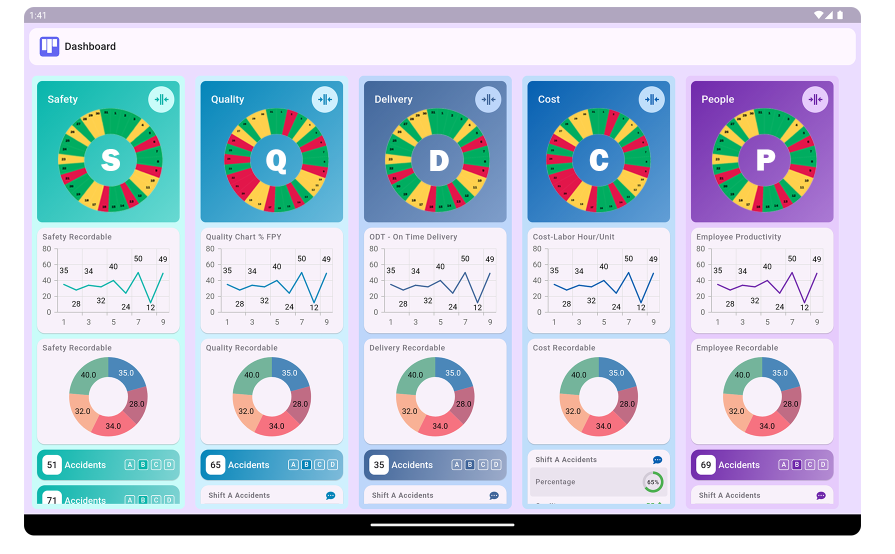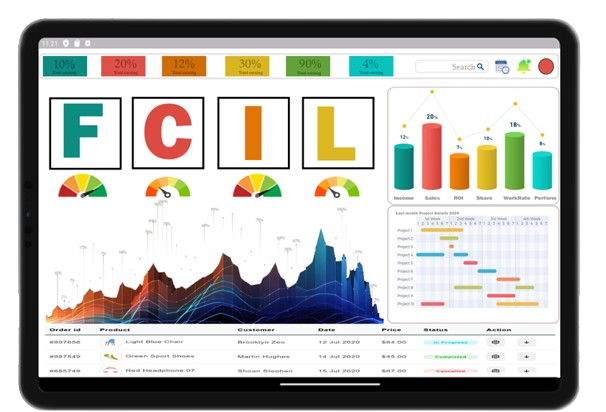A Digital Balanced Scorecard (BSC) Template is a powerful tool designed to help organizations align business activities with strategic goals and monitor performance across multiple perspectives. Unlike traditional scorecards, the digital version offers advanced capabilities such as real-time data integration, automation, and enhanced visualization, which aid in informed decision-making and agile responses to business changes. This template typically covers key areas such as financial performance, customer satisfaction, internal processes, and learning and growth.

What is a Digital Balanced Scorecard Template?
A Digital Balanced Scorecard Template is an interactive framework that enables organizations to track and manage their strategic objectives across different business areas. Initially introduced as a physical or spreadsheet-based tool, the balanced scorecard has evolved with digital transformation, allowing for more dynamic and comprehensive reporting. This template captures performance data from various sources and presents it in an easily interpretable format, ensuring that business leaders can maintain focus on key metrics, track progress, and identify areas requiring improvement.
Core Components of a Digital Balanced Scorecard Template
A Digital Balanced Scorecard Template comprises several essential components. Each component represents a critical aspect of business performance and together forms a complete view of organizational health:
1. Financial Perspective
Definition: The financial perspective focuses on measuring financial performance indicators that align with an organization’s revenue and profit goals.
Metrics: Common metrics under this perspective include revenue growth, profit margins, return on investment (ROI), and cost management.
Purpose: This perspective provides insight into how well the organization is meeting its financial objectives, allowing decision-makers to evaluate the sustainability and profitability of current strategies.
2. Customer Perspective
Definition: The customer perspective evaluates how the organization delivers value to its clients and measures customer satisfaction and loyalty.
Metrics: Examples include customer satisfaction scores, net promoter scores (NPS), retention rates, and customer lifetime value.
Purpose: This perspective helps organizations focus on enhancing customer experience, understanding client needs, and building lasting relationships that drive future growth.
3. Internal Processes Perspective
Definition: This perspective examines the efficiency and effectiveness of internal operations, ensuring that workflows are optimized to support customer and financial goals.
Metrics: Key metrics include process completion time, defect rates, and productivity levels.
Purpose: By monitoring internal processes, organizations can identify bottlenecks, reduce operational costs, and improve quality, thereby supporting better financial and customer outcomes.
4. Learning and Growth Perspective
Definition: The learning and growth perspective focuses on the development of human resources, technology, and organizational culture to foster innovation and continuous improvement.
Metrics: Metrics include employee satisfaction, skill acquisition rates, training completion rates, and technology adoption levels.
Purpose: This perspective aims to build a strong foundation for sustainable growth, ensuring the organization is equipped to adapt to market changes and future challenges.
Benefits of a Digital Balanced Scorecard Template
Using a digital balanced scorecard template provides a multitude of benefits that enhance strategic planning, monitoring, and performance management:
1. Real-Time Data Integration
Digital scorecards allow for real-time data updates by connecting to various data sources within the organization. This integration ensures that decision-makers always have access to the latest performance metrics, enabling timely responses to emerging trends.
2. Enhanced Data Visualization
Digital templates can include data visualization tools such as charts, graphs, and heat maps, which make complex data easier to interpret. Clear visual representations of data help teams quickly identify patterns, trends, and areas for improvement.
3. Improved Alignment with Strategic Goals
A digital balanced scorecard helps teams maintain focus on their strategic objectives by providing a structured framework that aligns day-to-day activities with long-term goals. This alignment promotes better prioritization and resource allocation across departments.
4. Increased Collaboration and Accountability
Digital scorecards facilitate collaboration by allowing different teams and departments to view and track their performance. The template provides clear accountability, ensuring that each team understands its role in achieving the organization’s strategic objectives.
5. Data-Driven Decision-Making
By consolidating data into a single, comprehensive template, a digital balanced scorecard enables leaders to make data-driven decisions. Access to accurate and relevant data allows for better strategic adjustments, resource allocation, and risk management.
Implementing a Digital Balanced Scorecard Template
To effectively implement a digital balanced scorecard template, organizations should follow these best practices:
- Define Clear Objectives: Establish specific, measurable goals for each perspective (financial, customer, internal processes, and learning/growth). This ensures alignment with the organization’s overall strategy.
- Select Relevant Metrics: Choose metrics that accurately reflect performance in each area. Each metric should be actionable, enabling teams to make necessary adjustments based on data insights.
- Integrate Data Sources: Connect the scorecard to relevant data sources to enable automated data collection and real-time updates. This integration reduces manual data entry and improves accuracy.
- Regularly Review and Update: Periodic reviews ensure that the scorecard remains relevant to evolving business goals. Make necessary adjustments to objectives and metrics to reflect changes in strategy.
- Engage Teams and Foster Accountability: Involve team members in the scorecard process to promote ownership and accountability. Regularly communicate the importance of each metric and how it contributes to the organization’s success.
Challenges of Using a Digital Balanced Scorecard Template
Implementing a digital balanced scorecard can come with challenges, including:
- Data Overload: With access to extensive data, it can be easy to become overwhelmed. Focus on the most critical metrics to avoid information overload.
- Maintaining Accuracy: For effective decision-making, data accuracy is paramount. Ensure regular data verification and monitoring to maintain reliability.
- Resistance to Change: Transitioning from traditional scorecards to a digital format may encounter resistance from teams unfamiliar with the new tools. Training and clear communication can mitigate this.
Digital Balanced Scorecard Template
What is a Digital Balanced Scorecard Template?
A Digital Balanced Scorecard Template is a tool designed to track strategic objectives, KPIs, and performance metrics. It provides an online format to monitor goals across financial, customer, process, and growth perspectives.

Why use a Digital Balanced Scorecard Template?
Using a Digital Balanced Scorecard Template enables organizations to align business activities with strategic goals, measure key metrics efficiently, and enhance decision-making with real-time data insights.
What are the key components of a Digital Balanced Scorecard Template?
The key components include financial, customer, internal process, and learning & growth perspectives. Each section contains specific KPIs that align with organizational goals and performance measures.
How does a Digital Balanced Scorecard Template help with performance management?
It centralizes data on key performance indicators (KPIs) and tracks progress toward objectives, providing insights on performance strengths and areas for improvement, leading to informed decisions.
Can the template be customized for different business goals?
Yes, Digital Balanced Scorecard Templates are highly customizable. Users can adjust metrics, objectives, and KPIs to align with specific business goals and industry requirements.
How does a Digital Balanced Scorecard support strategic planning?
It helps define, communicate, and track strategic objectives, ensuring that all actions align with organizational goals, which facilitates strategic planning and progress evaluation.
What types of KPIs are included in a Digital Balanced Scorecard Template?
Typical KPIs include financial metrics (revenue, profit), customer satisfaction scores, operational efficiency indicators, and employee development metrics, all relevant to the four scorecard perspectives.
Is it possible to track real-time data with a Digital Balanced Scorecard Template?
Yes, many digital templates support real-time data integration, allowing users to monitor KPIs as they update, providing a current view of organizational performance and progress.
How can the template enhance alignment across teams?
The template allows all teams to view and understand strategic objectives, ensuring that their activities align with overarching goals, promoting a unified direction for the organization.
What are the benefits of using a digital template over a manual scorecard?
Digital templates offer easier data updates, real-time insights, and automated reporting, saving time and reducing errors compared to manual scorecards, which are often labor-intensive.
Can small businesses benefit from a Digital Balanced Scorecard Template?
Yes, small businesses can use the template to align limited resources with strategic goals, monitor performance effectively, and make data-driven decisions for growth and sustainability.
How does a Digital Balanced Scorecard facilitate decision-making?
It provides a structured view of critical metrics and progress, enabling leaders to make informed decisions based on performance data across all key areas of the organization.
What is the financial perspective in a Digital Balanced Scorecard Template?
The financial perspective includes metrics like revenue, profit, and cost savings. It focuses on how effectively an organization achieves its financial goals and generates value for stakeholders.
How does the template track customer satisfaction?
The customer perspective tracks metrics like customer satisfaction scores, retention rates, and feedback, providing insights into how well the organization meets customer needs.
What is the role of data visualization in a Digital Balanced Scorecard Template?
Data visualization, such as graphs and charts, helps users quickly interpret KPI data, understand trends, and make data-driven decisions by presenting information in a clear, visual format.